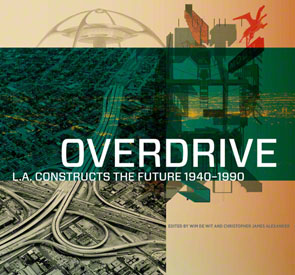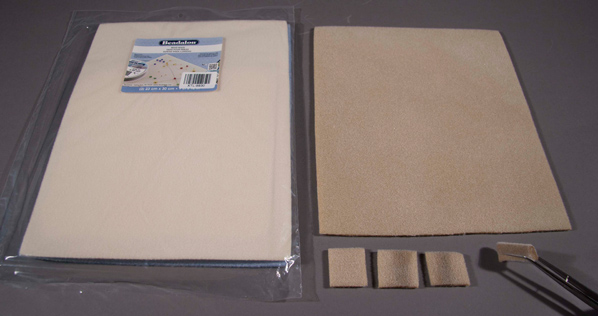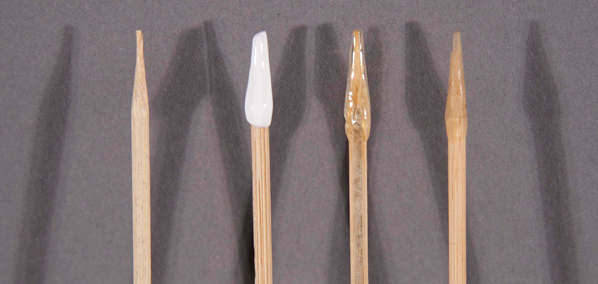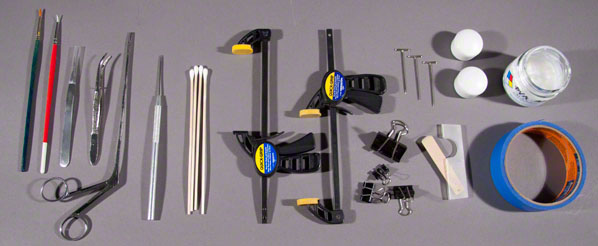
Working with colleagues from the Getty Conservation Institute on a model of “Open House” by Coop Himmelb(l)au, 1983. Photo: Scott S. Warren
Though intended primarily to benefit conservators in the field, this technical paper may also be of interest to you if you’ve ever wondered how architectural models—often fragile, and rarely made to last—are conserved by the museums that own them, what diverse purposes they serve, and the large range of forms they take. —Ed.
Since the 1980s, the Getty Research Institute (GRI) has built an outstanding collection of drawings, architectural models, photographs, architects’ papers, and rare books. The collection is especially strong in 20th-century European modernism and postwar California architecture. The archives of the architects Frank Israel, Ray Kappe, Pierre Koenig, John Lautner, Frederick P. Lyman, and Coop Himmelb(l)au, along with that of photographer Julius Shulman, have been resources for a current Research Institute project on the study of Southern California architecture, the results of which culminated in the exhibition Overdrive: L.A. Constructs the Future, 1940–1990 as well as a corresponding publication.

Cover of the catalog for Overdrive
Curated by Wim de Wit, head of the Research Institute’s Department of Architecture & Contemporary Art, the show not only focuses on famous L.A. architects, but also reveals lesser-known facets of the city’s development and character: mass suburbanization, freeways, coffee shops, gas stations, office buildings, parks, and even the 1984 Olympics.
I recently contributed to the conservation of several architectural models displayed in Overdrive. This paper will provide a glimpse into the conservation process of two of those models and the work of the Research Institute’s Department of Conservation and Preservation.
Very few people have researched the conservation of architectural models. Therefore, before beginning work, I surveyed my English- and German-speaking colleagues about their conservation approaches to such models. First, I’ll offer some brief definitions and a typology of architectural models, and a quick survey of their history.
What Is an Architectural Model?
An architectural model is a simplified three-dimensional mockup of an architectural drawing that visualizes the fundamental characteristics of a design in reduced but true scale, seen from a bird’s-eye view.

Image left: Drawing of the Residence for Mr. and Mrs. Stahl/Case Study House (CSH) 22 (1960) by Pierre Koenig. The Getty Research Institute, 2006.M.30.5. Image right: Model of the Residence for Mr. and Mrs. Stahl/CSH 22 (1980s/1990s) by Pierre Koenig. The Getty Research Institute, 2006.M.30.1
Types of Architectural Models
Authors group architectural models in various ways, but I will identify two categories: building models and site models.
Building models can be either working models or final models. Working models (also called sketching or block models) function as tools in the design process, allowing the architect to check shape, volume, and proportions. After evaluating these facets of the model, the architect usually goes back to correct his or her technical drawing. Working models are commonly made from simple and inexpensive materials like PlasticineTM, paper, pasteboard, corrugated cardboard, or soft plastic foam (for a quick model), and are scaled at 1:500 or even 1:1000.
Final models (also called presentation or display models) represent the design result and serve as a communication tool between the architect and a client. They can depict hard and soft, warm and cold, and/or solid and transparent materials, and can provide a guide for lighting as well as material costs. The materials that make up the final model often represent its character: Wood can signify the use of natural materials, long-established practices, and craftsmanship, whereas transparent plastic sheets indicate ease and transparency. Wire mesh, on the other hand, can be a metaphor for technical perfection. Usually, final models are scaled at 1:500, but they can sometimes be bigger, scaled at 1:200 or even 1:100. A subcategory of the final model is the competition model, a model submitted with a set of documents for an architecture competition.
Both the working and the final model can come with a detail model, scaled at 1:100, 1:50, 1:20, or 1:10, showing sections, interior details, or a façade’s particulars. Structure models also show these details, reveal a building’s construction, and can be disassembled.
Site models depict the abstracted environment of a building model at its same scale. Site models are usually made from less expensive materials than those used for the actual architectural design, such as cork, plaster, or cardboard, and they may vary in color. Vegetation is made from copper wire, nails and twigs, fine-cut mixtures of tea leaves, sawdust, foliage, Icelandic moss, yarrow, fly netting, sponge rubber flakes, dried flowers, or small toy pearls. Often, site models include miniature human figures to visually communicate the model’s scale.
History of Architectural Models
Models are usually intended to last only a short time. As they are also fragile and difficult to handle, comparatively few have survived.
From the ancient classical world, we only find an occasional literary mention of models. Plutarch, for instance, refers to architects presenting final models for a temple competition. In ancient and medieval times, models were used for symbolic purposes: visions of the afterlife in Egyptian tombs, clay funeral pots shaped like temples in Greece, Roman triumphs with models of captured cities, and medieval saints and angels holding church models to indicate donations, are all well documented.
It is not until the early 1400s that models were truly used as an architectural design tool. This development is directly linked with the discovery of linear perspective as well as the development of spatial thinking, and their incorporation into architecture theory. One of the earliest, clearest, and most forceful advocates of using architectural models was the Italian Leon Battista Alberti (1404–1472). Most models of his time, however, were polished and rhetorical representation models that have nothing in common with working models. Working models did not become common until the advent of Modernism in the early 1900s. By the end of the 1900s, tactile models were increasingly eclipsed by digital realizations.
Today, there exist two types of architecture models: touchable, “old-school” analog models; and virtual models, which can be fabricated into physical models by laser cutting or built by a 3D printer that represents a border area between analog and virtual.
State of Research on Architectural Models
Two groups of professionals investigate and preserve architecture and its models: specialized art historians and conservators, who mainly work in museum environments—as well as a few model makers who mostly work alongside architects.
Architectural Models in Museum Collections
There is hardly any museum that does not own an architecture model, even if only of its own building. Various museums have more in-depth collections, which the International Confederation of Architectural Museums (icam) lists on its website. The Getty Research Institute, the Museum of Modern Art (MoMA) in New York, the Victoria and Albert Museum (V&A) and the Royal Institute of British Architects (RIBA) in London, the Museum für Angewandte Kunst (MAK) and the Wien Museum in Vienna, the Centre Canadian d’Architecture (CCA) in Québec, and the Deutsches Architekturmuseum (DAM) in Frankfurt (see its 2012 exhibition and publication The Architecture Model – Tool, Fetish, Small Utopia), are just a few examples. See the list of literature at the end of this article for further resources on architectural models.
Studies on the Conservation of Architectural Models
Little systematic work been done on conserving architectural models, and there are few publications in this area. Recently, however, there has been an upswing in research published on these objects. Most are general statements on preservation of architectural models, or brief descriptions of specific treatments. A few, mostly published since 2010, offer systematic contributions to the field of model conservation.
A few examples of recent papers and book on model conservation:
- Curator Jari Jetson, in his book Little Big Houses from 2001, recommends preserving the patina of models that have been altered, and even those that have deteriorated with age. He believes we should only return a model to a state close to the original if we have sufficient evidence of its original appearance, but that we should surely not make it look new again.
- Nigel Bamforth, senior furniture conservator at the V&A, briefly summarizes his treatment of the model for Gate of Yomeimon of Toshogu in the 2004 online edition of the V&A Conservation Journal with a brief conceptual discussion, and provides an accessible insider’s look into the field of model conservation.
- Margo Delidow, a research fellow in the Sculpture Conservation Laboratory at MoMA, developed guidelines for conserving, surveying, storing, and exhibiting architecture models in the museum’s collection. These guidelines, modified as necessary for particular museums’ holdings, could surely be applied to other collections. Her discussion includes results of a questionnaire sent to architects that surveyed their opinions on the acceptable extent of visible aging in a model, as well as their preferences on restoring versus replacing damaged or degraded parts. Architects tended to prefer replacements over repairs, but only of strongly aged elements, in order to not lose the original design. Margo’s work will be published in the Journal of the American Institute of Conservation(JAIC) in spring 2013.
- Marianne de Bovis’s master’s thesis at the École nationale supérieure des arts visuels de La Cambre (ENSAV La Cambre) in Brussels, focuses on the conservation of an ensemble of paper models. She provides a comprehensive research summary on paper-model conservation, both by surveying the published literature and by interviewing paper-model conservation experts in Europe and the U.S.
- Marilyn Meerschiff at the Hochschule für Technik und Wirtschaft (HTW) in Berlin, also discusses in her diploma thesis the conservation of an ensemble of models—though hers feature a larger variety of materials, as they include paper, wood, metal, glass, and plastic. Her approach is based on a comprehensive investigation and evaluation of the literature on each of these various materials. A unique strength of her thesis is her discussion of the use of the material mix polymethalymethacrylate (PMMA) to paper. She analyses the literature on PMMA and supports her decision to use a specific adhesive through a series of tests. Furthermore, she explains her approach to cleaning a specific model, one with an aged appearence, in relation to its status as a working model.
- In 2012, Jasmin Abfalter finished her unpublished diploma thesis at the Universität für Angewandte Kunst (die Angewandte) in Vienna. She conserved two models with various materials such as foam core board, paper, wood, metal pins, and pressure-sensitive tape. In her thesis she draws her conclusions from published literature, but also describes the results of a large number of test series. She nicely describes her approach to handling pieces of tape that have become detached from paper, details the models’ various materials and fabrication processes, and shares the difficulties she encountered during their conservation—including an interesting treatment solution I’ll discuss below.
Conservation Survey
I joined the Getty Research Institute’s Department of Conservation and Preservation in 2011 and began working on the conservation of architecture models made from a great variety of materials. Some materials, such as wood, metal, glass and plastics, were more familiar to me than others, such as paper, pressure-sensitive tape, and the various materials used to model the vegetation surrounding a structure.
Before beginning work, I did a broad online search, as well as a survey of model conservators in museums with larger model collections. The names of the conservators who kindly participated are listed in the acknowledgments at the end of this post. I asked the following questions:
- Are there publications, theses, or unpublished treatment papers you know of?
- What is your approach/decision-making process toward a model treatment?
- Do you—and how do you—examine models prior to treatment?
- What kind of conservation materials do you use?
- How do you document treatments, and do you use any standardized treatment reports?
It was clear that there is no such thing as a general approach, a finding I confirmed through research in the existing literature. Models are made in various shapes and with various materials, so conservation issues need to be solved individually and in cooperation with specialized conservators, with scientists who can assist with material identification, and with curators, as well as with architects, who can help elucidate the maker’s intention. In particular, treatments that include material mixes with plastics need further investigation. Professionals who work on such projects should be encouraged to publish more.

FTIR-analysis of the paint in the Open House (1983) by Coop Himmelb(l)au. The Getty Research Institute, 2002.M.2.6

I discuss a treatment with curator Wim de Wit on the Gould/LaFetra House model(1966/1968) by Ray Kappe. The Getty Research Institute, 2008.M.36.2
Conserving Architecture Models: Two Examples from Overdrive
The Getty Research Institute’s collecting priority is working models, which reveal the process of a specific architecture project. But the collection also includes quite a few final models as well.
Two of these final models are the Open House by Coop Himmelb(l)au and the Gould/LaFetra House (also called the Gould/Jacobson House) by Ray Kappe. They greatly differ in structure and materials, so I will compare their conservation treatment and the tools used.

Final model for Open House (1983) by Coop Himmelb(l)au. The Getty Research Institute, 2002.M.2.4

Final model for Gould/LaFetra House (1966/1968) by Ray Kappe. The Getty Research Institute, 2008.M.36.2
Object Description and Condition
The Gould/LaFetra House model from 1966/1968 is a wooden structure with pale cardboard floors and roofs mounted to a cork base and supported by a plywood board underneath. Most of the base and structure, except for the turquoise chimneys, is uncolored, but there are a few blue papers applied to selected surfaces, such as the front door and the pool.
Made in 1983, the model for the Open House has a plastic structure with a polymethylmethacrylate (PMMA) base, in which a polystyrene (PS) construction is inserted and partially supported by foam blocks and foam boards. Its transparent areas are closed with PS sheets. Filigree metal hand rails secure all the platforms. The pool, on the other hand, is made from wood with a wavy glass surface. All solid areas are spray-painted with an alkyd resin. The model was originally positioned on a gigantic wooden base that will not be included in Overdrive (and which is therefore omitted in these images).
Both the models came into the Research Institute’s collection with debris, structural damage, and losses, as seen in the images below.

Gould/LaFetra House model before treatment, with the two main areas of damage

Detail of debris, damaged, and detached elements on the Gould/LaFetra House model, before treatment

Detail of debris with damaged and detached elements on the left side of the Gould/LaFetra House model, before treatment

The Open House model before treatment, showing detached elements

Detail of the Open House model before treatment, showing open joints
Treatment Discussion and Material Analysis
In order to choose a proper treatment and the right conservation materials, we consulted the curators of the Research Institute’s architecture collection; Tom Learner’s science lab at the Getty Conservation Institute undertook analysis of the plastic materials in the Open House model.
During discussions, the curators and conservators agreed that we should attempt to reconstruct the area of loss on the front of the Gould/LaFetra House model, so as not mislead future viewers about the architect’s original design. Fortunately, there was enough evidence from the original’s remains for us to determine the dimensions of the missing pieces. We also confirmed the model’s original appearance through further research. Had this not been the case, we would have accepted the object’s damaged condition, since it is imperative not to change the architect’s intent.

Reconstructions (indicated by green lines) added to the model of the Gould/LaFetra House
Cleaning Techniques
After determining a treatment proposal, conservators usually begin by cleaning an object. A dry cleaning technique is often most suitable for an architectural model. We used a Nilfisk vacuum cleaner with HEPA filters that collect the very finest dirt particles. We attached micro tools to the trunk of the vacuum cleaner for a careful, but at the same time efficient, work procedure for stable areas.

Dry cleaning the Open House using a vacuum cleaner with micro tools
For more fragile areas, we removed the micro tools, lowered the suction power, and used small soft-hair brushes

Micro tools, a piece of Hollytex® (lightweight), and brushes of various lengths and sizes used to clean architectural models
To prevent the vacuum cleaner from sucking up any loose model pieces, we inserted a piece of Hollytex® between the parts of the vacuum trunk. The piece was pushed a bit into the trunk to maximize the dust-collecting surface and to prevent the vacuum cleaner from clogging too quickly. Once in a while, we opened this connection and bagged all the remains in small polyethylene (PE) bags. They would later be stored with the object.

Vacuum cleaner with inserted Hollytex® filter
Some surfaces still appeared less than clean after vacuuming, so we decided to apply further cleaning techniques.

Cleaning the model of the Gould/LaFetra House using BEADALON® bead mat pieces
For coarse-pored surfaces such as cork or wire mesh, a durable foamlike material called bead mat by BEADALON® can help. Its surface is designed to keep beads from rolling, but also to collect fine dirt particles between its fibers. The material can even be used in very fragile areas where standard cleaning techniques might cause damage, since the textile does not require pressure, and therefore is very gentle. Tools such tweezers can be used to handle small-cut pieces. Furthermore, the mats are washable and reusable. This cleaning material was identified by conservator Linda Roundhill, owner of Art and Antiquities Conservation, LLC, and introduced to me by conservator Jane Bassett from the Department of Sculpture and Decorative Arts Conservation at the J. Paul Getty Museum.

Cleaning with BEADALON® bead mat textile
Another advanced cleaning technique employs Lascaux® Acrylic Adhesive 360 HV on a wooden stick. The stick can easily be prepared by dipping its tip into the adhesive. This adhesive remains sticky after drying to a film, and therefore can collect dirt even from surfaces such as wood and paper, and can give access to narrow edges and corners. This technique derives from paintings conservation, where it is used to carefully clean paint flakes.

1. Wooden stick 2. Wet Lascaux adhesive 3. Dried Lascaux adhesive 4. Used tool
Glossy and shiny surfaces on plastics, on the other hand, can easily scratch when dry-cleaned. We observe this phenomenon, for instance, on display bonnets made from polymetylmethacrylate (PMMA, Plexiglas®), which suffer circular scratches from abrasive dust particles. During the three-and-a-half-year-long research project POPART, specialists throughout the world investigated the best cleaning techniques for plastics. They concluded that using lubricants while cleaning would noticeably reduce surface damage.
The dirt on the plastic surfaces of the Open House model was water soluble. Since polystyrene (PS) is not harmed by water, we cleaned the transparent plastic sheets using water with a minimal detergent addition, followed by purification with distilled water, so as not to leave water stains. The same cleaning technique was applied to the painted model surface.

Cleaning the painted surfaces on the Open House model
Adhering Techniques
Different structures and materials require different conservation materials, as well as different techniques, for assembling detached parts. Wooden constructions are commonly reassembled using hide glue, an adhesive consisting of proteins from animal skins or bones. The rectangular construction of the Gould/LaFetra House model, allowed us to use traditional assembling tools such as lightweight clamps. In rare cases, when pieces were too small or in inaccessible areas, we used light weights or low-adhesion ScotchBlueTM tape.

Various hide glues and lightweight clamping tools used to work on traditionally built wood models
Readhering parts on plastic models is often more complicated, not only because we need to use reliable analytical instruments to identify materials before reassembling them, but also because we need to carefully choose the most appropriate adhesive for each specific plastic. Many plastics are used in art objects containing very many components, which can also differ depending on when a plastic was made. In addition, the discipline of plastic conservation is still a young one, having existed for only 20 years (compared to the preservation of culture heritage more broadly, established for over a century). This is why we still gain conservation knowledge of plastics with each project, and will proceed with similar investigations in future years. One final challenge of working with plastics is that the makeup of plastic components keeps changing. For all these reasons, we must be careful in choosing an adhesive: it should not degrade the material, should not age (yellow or change adhesion properties), and ideally should be removable, in case a better way of treating an object be found in the future. In short, the decision-making process for plastics is more complex than for other materials.
In the Open House model, the construction was built up in three layers, which all came to us with detached elements. Furthermore, the model would travel for the exhibition, which can cause mechanical impact on its joints. The chosen adhesive should, therefore, resist aging and provide great tensile strength: it would be very difficult, for instance, to reach a reopened joint in the model’s interior, and such an opening could even cause structural weakening. The transparent polystyrene sheets at the base of the model, with their rigid construction, could be readhered using an aqueous adhesive. All this thinking led us toward a polyvinyl acetate (PVAc) adhesive, which is fairly stable in terms of yellowing and pH-changes, but definitely has good strength.

PVAc adhesive and application tools such as brushes, tweezers, and scribers, as well as lightweight positioning tools
Just as the process of choosing an adhesive can be complicated, so too are the techniques used to apply it. Because architectural models are often lightweight constructions made of delicate materials, we often place pieces together using supports such as T-pins on foam blocks or wooden sticks, as well as small-size weights or binder clips, and sometimes even low-adhesion ScotchBlueTM tape for securing pieces lightly into place. The tape’s ends are folded in to minimize the surface area it contacts, and to ease its later release.

Image left: Reattaching elements on the Open House model by positioning with t-pins on foam block. Image right: Reattaching using binder clips

Reattaching pieces on the Open House model using a combination of binder clips and weights, such as stoppers

Reattaching pieces with ScotchBlue™ tape for delicate surfaces, used in rare situations

Reattaching pieces on the Open House model using sticks with cotton tips as positioners
Conclusion
Conserving architecture models is quite challenging, but at the same time very interesting, due to the variety of materials used in the models, often including low-quality materials, assembled quickly. Very little has been published on conserving architectural models and their material mixes, which makes it a young discipline in the conservation field, and one that calls for further investigation as well as more publications to facilitate better exchange among colleagues.
This paper is related to the exhibition Overdrive: L.A. Constructs the Future, 1940–1990 and provides an inside look at some of the preparation work undertaken by the Getty Research Institute’s Department of Conservation and Preservation. I compared one wooden and one plastic model in their materials, conservation approaches, and treatments. I also outlined a few conservation “tricks” in the areas of cleaning techniques and readhesion of flimsy model pieces. I further summarized the current state of research on conserving architecture models, and provided an introductory typology and general history of such models.
Acknowledgements
Lisa Nash, conservator at RIBA, London, UK
Karen Potje, head conservator at CCA, Québec, Canada
Regula Künzli, object conservator at the Wien Museum, Vienna, Austria
Nigel Bamforth, senior conservator at the V&A Museum, London, UK
Christian Walter, model conservator at DAM, Frankfurt, Germany
Rodger Griffith, conservator at MoMA, New York, USA
Margo Delidow, former fellow at MoMA, New York, USA
Jasmin Abfalter, Vienna, Austria
Marianne de Bovis, Washington DC, USA
Marilyn Meerschiff, Berlin, Germany
Wim de Wit, curator at the Getty Research Institute, Los Angeles, USA
Tom Learner, scientist at the Getty Conservation Institute, Los Angeles, USA
Jane Bassett, conservator at the J. Paul Getty Museum, Los Angeles, USA
Tobias Friedrich, conservator at the MAKK, Cologne, Germany, for his translation of Marianne de Bovis’s paper from French.
Literature
Jasmin Abfalter: Zwei Architekturmodelle von Frank O. Gehry: Untersuchung, Konservierung und Restaurierung: Die Verbundplatte aus materialwissenschaftlicher Sicht. Unpublished diploma thesis Universität für Angewandte Kunst Wien 2012.
Franz Bischoff: “…das verkleinert opus recht vor Augen gestellt”: Zur Geschichte und Bedeutung des Architekturmodells von der Frühzeit bis zur Gegenwart. In: Rom über die Alpen tragen: Fürsten sammeln antike Architektur: Die Aschaffenburger Korkmodelle. Ed. by Werner Helmberger, Valentin Kockel. Ergolding 1993, p. 33-48.
Jan Gerchow, Petra Spona: Das Frankfurter Altstadtmodell der Brüder Treuner, Frankfurt 2011
Hazel Conway, Rowan Roenisch: Understanding Architecture: An Introduction to Architecture and Architectural History. London, New York 2005
Marianne de Bovis: La Conservation – Restauration des Maquettes en Papier et Carton. Unpublished diploma thesis École nationale superieure des arts visuels de La Cambre, Brussels 2010
Jane L. Down: Poly(vinyl Acetate) and Acrylic Adhesives: A Research Update. In: Holding It All Together: Ancient and Modern Approaches to Joining, Repair and Consolidation. Ed. by Janet Ambers et al. London 2009. pp. 91–98.
Oliver Elser, Peter Cachola Schmal: The Architectural Model: Tool, Fetish, Small Utopia. Frankfurt 2012
Kenneth Frampton, Silvia Kolbowski: Idea as Model. New York 1981
Meinhard von Gerkan et al.: Idea and Model. 30 Years of Architectural Models. Berlin 1994
Rolf Janke: Architectural Models. London 1968
Jari Jetson: Little Big Houses: Working with Architectural Models. Tampere 2001
Heinrich Klotz: Architektur des 20. Jahrhunderts: Zeichnungen, Modelle, Möbel. Stuttgart 1989
Burkhard Lüdtke: Modell, Architektur, Design: Die Lehre vom Architekturmodellbau. Berlin 2002
Marilyn Meerschiff, Victoria Areal: Ein Ensemble aus Architekturmodellen aus den 1950er Jahren. Unpublished diploma thesis, Hochschule für Technik und Wirtschaft, Berlin 2010.
Mark Morris: Models: Architecture and the Miniature: Architecture in Practice. Chichester 2006
Coop Himmelb(l)au: Beyond the Blue. Vienna 2007
Tom Porter, John Neale: Architectural Supermodels: Physical Design Simulation. Oxford, Woburn 2000
Yvonne Sashoua et al.: Studies in Active Conservation of Plastic Artefacts in Museums. In: Preservation of Plastic Artefacts in Museum Collections. Ed. by Bertrand Lavédrine, Alban Fournier, Graham Martin. Paris 2012, pp. 217–268.
The Getty magazine, J. Paul Getty Trust, ed., 2012. Los Angeles, pp.8–9.
Michael Webb: House Design Ray Kappe: Architects/Planners. Hong Kong 1998




Dear sir
My name is Maria José Távora, and I´m Portuguese.
I´ve been a museum curator for 20 years, and some years ago I decided to go again to the University and study Conservation and Restoration. At the moment, I work as a conservator-restorer, and I’m concluding my master in sculpture conservation and restoration at te Oport Catholic University.
My father (Fernando Távora) was an architecture, and teacher at the Oporto School of Architecture for almost 40 years. I grew up in the midle of my father schetches and models, I played with then when I was a child. But now, all my father architectural heritage is in a Foundation that belongs to the Oporto University (http://fims.up.pt/ ).
Joining all this ideas, I decided to explore de conservation and restoration of architectural models in my Master Thesis.
Reading the work you have done with some models, my question is :
Do you have a Curator or a Restorer for the models? Or they are preserved by Architects? Or by model maker’s?
Is there a protocol to touch then, to move then?
Thank you very much for your time,
Best regards,
Maria José Távora
Thank you very much for your comment! The Getty Research Institute has a Department of Conservation and Preservation, staffed by professional conservators, that is in charge of conservation and storage of all the GRI’s special collections objects, including its architectural models.
To learn more about standard protocols for conservation and handling of architectural models, conservator Mark Benson in that department recommends the article “Architectural Models: Materials, Fabrication, and Conservation Protocols” by Margo Delidow (Journal of the American Institute for Conservation, February 2013, 52:1).
Thanks again — Annelisa / Iris editor
Thank you very much for the article. If I need, I’ll keep in touch.
Regards,
Maria José Távora